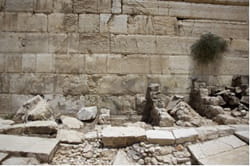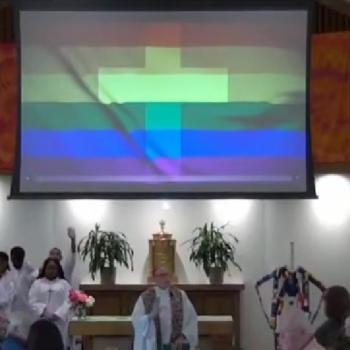Objection to Animal Sellers.
When Jesus entered the temple, he found people selling sacrificial animals (Jn. 2:14). What where they doing there? Jews were required to perform sacrifices at the temple for a number of reasons. Generally speaking, this involved bringing or purchasing an animal, laying one's hands on it, and then giving it to the priests to sacrifice (Talmud, Bezah 20a-b). Frequently part of the meat from the sacrifice was returned to the sacrificer. The animal sellers in the temple were simply selling the animals needed for these sacrifices. Given the difficulties of bringing the required sacrifices from a distance, having animals available for purchase would have provided an important service for pilgrims. In and of itself, this practice was not objectionable. Jesus was not an animal-rights advocate who objected to the very idea of animal sacrifice. Rather, his objection was that the animals were being sold inside the temple precinct. There was, in fact, a special market outside the temple called the Ḥanuth where the sacrificial animals were sold. One problem with selling animals inside the temple was that their defecation and urination could not but profane the temple courtyards. If animals were mixed with throngs of pilgrims it would become inevitable that manure and urine would be tracked throughout the temple plaza. There was a specially designated section of the plaza north of the sanctuary into which the animals were brought through the northern gate. The other problem was that selling animals meant that financial transactions were undertaken in the temple, linking to the next objection.
Objection to Money Changers Why were there money changers in the temple?First-century Judaism required that all adult male Jews pay an annual half-shekel temple tax (Ex. 30:16). This money was used for the maintenance of the temple, and to pay for animals for the daily temple sacrifices made by the priests on behalf of all Israel. Only Tyrian shekels of a specific weight and purity were acceptable for payment of the temple tax (Mishnah, Shekalim 1. 3, 2. 1). Jesus' objection was again not with money-changers per se, who filled an important function, but with changing the money within the temple precinct. There were, in fact, special stores had been built into the outer wall of the hieros designed for all financial transactions related to temple worship (see photo). But these transactions were to be conducted outside the temple. Furthermore, if a person brought ordinary Roman or Greek money into the temple, they were surreptitiously bringing images of foreign gods into the temple. If the money was changed outside the hieros precinct, then only the legitimate Tyrian shekels were brought into the temple itself. Changing money inside the temple defeated its purpose, since you had to bring the coins with images of foreign gods inside the temple to exchange them. Exchanging money outside the temple protected its sanctity from images of foreign gods. Exchanging the same money inside the temple profaned its sanctity. The Mishnah emphasizes the tradition against bringing money into the temple; a man "may not enter into the Temple Mount with his staff or his sandal or his wallet, or with the dust upon his feet" (Berakoth 9. 5; see also Mishnah, Sheqalim). Thus, Jesus' objection was not to the temple sacrificial system, but to abuses in that system which profaned "my Father's house." Jesus' objection is explicit: "Do not make my Father's house a house of commerce" (Jn. 2:16). Jesus did not intend to disrupt and reject temple service, but to purify and correct the improprieties of temple service as practiced in his day. It is quite possible that many of the Jews and even some of the priests who witnessed this purification supported Jesus and his goals. Certainly Jesus' disciples saw his act as a bold affirmation of the sanctity of the temple, since it reminded them of a Psalm: "Zeal for your house will consume me" (Ps. 69:9).
Why were there money changers in the temple?First-century Judaism required that all adult male Jews pay an annual half-shekel temple tax (Ex. 30:16). This money was used for the maintenance of the temple, and to pay for animals for the daily temple sacrifices made by the priests on behalf of all Israel. Only Tyrian shekels of a specific weight and purity were acceptable for payment of the temple tax (Mishnah, Shekalim 1. 3, 2. 1). Jesus' objection was again not with money-changers per se, who filled an important function, but with changing the money within the temple precinct. There were, in fact, special stores had been built into the outer wall of the hieros designed for all financial transactions related to temple worship (see photo). But these transactions were to be conducted outside the temple. Furthermore, if a person brought ordinary Roman or Greek money into the temple, they were surreptitiously bringing images of foreign gods into the temple. If the money was changed outside the hieros precinct, then only the legitimate Tyrian shekels were brought into the temple itself. Changing money inside the temple defeated its purpose, since you had to bring the coins with images of foreign gods inside the temple to exchange them. Exchanging money outside the temple protected its sanctity from images of foreign gods. Exchanging the same money inside the temple profaned its sanctity. The Mishnah emphasizes the tradition against bringing money into the temple; a man "may not enter into the Temple Mount with his staff or his sandal or his wallet, or with the dust upon his feet" (Berakoth 9. 5; see also Mishnah, Sheqalim). Thus, Jesus' objection was not to the temple sacrificial system, but to abuses in that system which profaned "my Father's house." Jesus' objection is explicit: "Do not make my Father's house a house of commerce" (Jn. 2:16). Jesus did not intend to disrupt and reject temple service, but to purify and correct the improprieties of temple service as practiced in his day. It is quite possible that many of the Jews and even some of the priests who witnessed this purification supported Jesus and his goals. Certainly Jesus' disciples saw his act as a bold affirmation of the sanctity of the temple, since it reminded them of a Psalm: "Zeal for your house will consume me" (Ps. 69:9).
Destroy this Temple
After Jesus' audacious act, he was confronted by some of the temple leaders, asking, "What sign do you show us for doing these things?" (Jn. 2:18). As I've noted before, throughout John the Jews ask for signs to authenticate Jesus' claims. The sign they are asking for here seems to be a validation of Jesus' implicit claim of authority to purify the temple. Oddly, Jesus did not give a sign or even directly address their question. Rather, he makes this enigmatic statement: "Destroy this sanctuary (naos), and in three days I will raise it up" (Jn. 2:19). Notice that whereas Jesus had purified the hieros/temple plaza, here he talks of the naos, meaning the central sanctuary. Indeed, John 2:19-21 is the only place in John where naos is used. Everyone, including the disciples, understood that Jesus was talking about the central sanctuary, and the Jews mocked his claim (2:20). This prophecy was apparently widely known among the Jews. Matthew and Mark report that "false witnesses" at his trial accused him of claiming he would destroy the naos and rebuild it in three days (Mt. 26:61; Mk. 14:58). (The "false" part of the accusation seems to have been that Jesus himself would destroy the temple. ) Others mocked him on the cross about the claim (Mt. 27:40; Mk. 15:29; cf. Acts 6:14).





